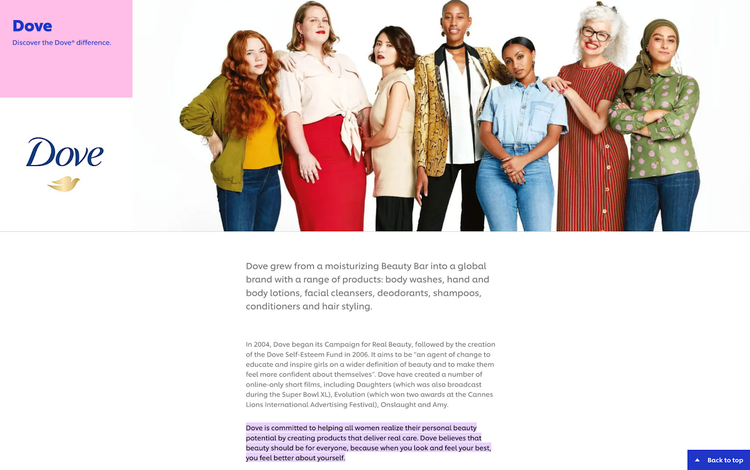Product positioning: benefits, types, and examples

Great products solve consumers’ problems by addressing their pain points. If a service or item can make a person’s life easier, there’s a good chance it can find an audience, gain popularity in the market, and become a success.
Successful companies use product positioning to demonstrate the benefits of their goods or services to consumers. Done right, product and brand positioning can help convince consumers that your product — not that of your competition — is worth buying. This product marketing tactic can create leads, boost conversions, help with retention, and increase profits.
Below, we explain what product positioning is, show the benefits, and discuss various types of product positioning. We also look at a few examples of brands that have perfected product and brand positioning.
Summary/Overview
What is product positioning?
Product positioning is a strategic marketing tactic that aims to differentiate a given product or service from similar, competing offerings by creating a unique product image in the minds of its intended target audience. By creating a distinct identity for a product or service, brands can occupy a favorable space in a consumer’s perception, influencing their purchasing decisions.
In short, product positioning is all about setting your product apart from the competition. What makes your offerings favorable when compared to the competition? Why should consumers purchase your product or service?
Effective product positioning requires you to understand three things:
- Your target audience. Which market segment are you trying to reach and what problem does your product solve? To help answer these questions, create a buyer persona, including demographic and behavioral information like age, gender, location, hobbies, and habits. This will help you determine customer needs.
- The market. Know what your competitors are doing to figure out how to stand apart from them. Do market research to examine the alternatives to your product. You can look at competing products, conduct consumer surveys, and host focus groups.
- The product. What is your product’s unique selling proposition (USP)? What makes it different from similar, competing products? For example, maybe your brand offers unique product features or provides a distinct customer experience. A Strengths, Weaknesses, Opportunities, and Threats (SWOT) analysis is one way to assess your product and answer these questions.
Benefits of product positioning
Product positioning requires time and effort, from organizing focus groups to engaging in competitor analysis. Is it worth it? You bet.
Product positioning is a vital part of any successful product management strategy because it helps solidify your market position and influences the perception of your product. There is no such thing as a comprehensive product strategy without proper product positioning.
Here are some examples of what makes product positioning important:
- Differentiation from competitors. By accentuating your product’s unique benefits, you can show your audience how it’s different from similar products on the market. This uniqueness can help convince people to pick your product instead of “the other guy’s.” Your unique value proposition gives you a competitive advantage.
- Increased sales. Differentiation plays a pivotal role in attracting consumers. More specifically, accurate product positioning resonates with your target customers — your ideal audience. This can create leads and sales.
- Increased brand awareness. Product differentiation can also boost your brand visibility. Some of the world’s most successful brands have rooted their success in creating products that are unique from what’s already on the market. Fast Company has some interesting case studies of innovative brands like Waterdrop.
- Improved customer understanding. Product differentiation helps demonstrate what a product is, and isn’t, so customers have a better idea of what to expect from the good or service. Setting customer expectations is important to avoiding disappointment, which can result in unhappy customers and bad reviews (not to mention the loss of customer loyalty).
- Prove your product’s value. Product differentiation can also help demonstrate why your product is valuable and why customers should pay a certain price. This is especially important if your product is at a higher price point than competitors’ products. You need to be able to justify those extra dollars they’ll be spending. This can help inform what’s called a premium pricing strategy.
What is a product positioning statement?
A product positioning statement is a concise announcement that communicates how a product or service fulfills the needs of a specific target market that differentiates it from competitors. It typically outlines the unique selling proposition (USP), target audience, and key differentiators of the product or services.
For example, a product positioning statement for a clothing brand that focuses on sustainability might look something like this: “Our product provides eco-conscious outdoor adventurers with sustainable functional alternatives that minimizes environmental impact while remaining durable and long-lasting. By reducing carbon footprint, using responsibly sources materials, and promoting a circular economy, we aim to empower individuals to make environmentally conscious choices without compromising style or quality.”
Having a product positioning statement is crucial part of any successful product positioning strategy for a handful of reasons:
- Clarity: A clear and focused articulation of what the product or service is, who it is for, and why it is unique helps guide decision-making in product development, marketing, and communication.
- Differentiation: A positioning statement helps differentiate the product or service from others in a competitive market. It highlights what sets the product or service apart and why consumers should choose it over other competitors.
- Targeted marketing: Product positioning statements identify the target audience, which is a crucial part of creating an effective marketing strategy. Tailoring messaging to a specific group of people improves the chances of the product or service resonating with the intended consumers.
- Consistency: It serves as a reference point for all communication efforts. Product positioning statements ensure a consistent message is conveyed across various channels, strengthening brand recognition and uniformity.
In short, a product positioning statement is a foundational tool that helps businesses navigate the complexities of the market while maintaining a distinct and appealing brand identity for their products and services.
Types of product positioning
Different types of product positioning strategies emphasize different aspects of a product. Here are some of the most popular options:
- Price positioning. If your product is set at a more affordable price than others, you can emphasize this through price positioning. Walmart is a good example of price positioning — affordability is their core focus.
- Quality positioning. Cheaper doesn’t necessarily mean better. Instead of price, consider winning over consumers’ minds (and wallets) with quality positioning. This could underscore aspects like quality materials or craftsmanship. Luxury brands from Chanel to Tesla use quality positioning.
- Feature positioning. A product with standout features that are unique to their market can use feature positioning. Apple is a great example of feature positioning, as the company’s products often feature new and improved functionality and characteristics that similar technology has yet to implement.
- Benefit positioning. Benefit positioning harkens back to your customer’s pain point. With this tactic, you emphasize the benefit the product brings to the customer’s life. Uber and Lyft are examples of brands that emphasize benefits.
- Image positioning. Image positioning speaks to deeper values that resonate with consumers’ core values. A brand like Ben & Jerry’s, known for its socially and environmentally conscious initiatives, is a great example of this.
- Competitive positioning. Competitive positioning is about showing you’re better than “the other guy.” You can do this directly or indirectly. Check out examples of brands that called out their competitors for an idea of how it’s done.
The right product positioning strategy can inform successful product marketing. If you’re launching a new product, you might use feature positioning to emphasize its unique traits. This can then guide your marketing strategy. You might decide to create a product video to showcase those traits.
How to create a product positioning strategy in 8 steps
Positioning a product effectively is crucial for creating a distinct and desirable space for it in the market. Follow these eight steps to create a successful product position strategy to boost your marketing efforts:
- Identify your target audience. Understand your target audience's needs, preferences, and pain points. Conduct market research and gather insights to tailor your product's positioning to address their specific requirements.
- Analyze your competitive landscape. Conduct a thorough analysis of your competitors to identify gaps in the market and areas where your product can stand out. Differentiate your product by highlighting its unique features and advantages.
- Define a unique selling proposition (USP). Clearly articulate your product's USP — the single most compelling benefit that sets it apart from competitors. What is your product’s selling point and how is it different from the competition’s? Use this USP as a core element in your product's positioning strategy and for drafting your product positioning statement.
- Choose the right messaging. Craft persuasive messaging that communicates your product's key benefits in a way that resonates with your target audience. Use language and tone that align with your brand personality and appeals to the emotions of your customers.
- Select appropriate marketing channels. Identify the most suitable marketing channels to reach your target audience effectively. Utilize a mix of social media, advertising, content marketing, and other relevant platforms to promote your product and reinforce its positioning.
- Leverage influencers and testimonials. Collaborate with influencers or industry experts to endorse your product and reinforce its value. Additionally, share testimonials and user-generated content that highlights positive experiences from satisfied customers.
- Price your product strategically. Determine a pricing strategy that aligns with your product's positioning. Whether you opt for premium pricing to convey exclusivity or competitive pricing to attract a broader audience, ensure it complements your overall positioning strategy.
- Monitor and adapt. Regularly monitor the market, gather customer feedback, and track the performance of your product's positioning. Be prepared to adapt your positioning strategy based on market changes and customer insights.
By following these steps, you can effectively position your product in the minds of your target customers, differentiate it from competitors, and create a compelling and memorable presence in the market.
Product positioning examples
Consider these winning examples of product positioning and let them inspire you with positioning your own products. Here are a few companies that show how a product positioning statement can make a difference.
Apple

Apple positions itself as a high-quality, premium brand on the cutting edge of technological development. The brand’s mission emphasizes this innovation-centric slant, with an aim “to bring the best user experience to its customers through innovative hardware, software, and services.”
Apple’s mission statement emphasizes the brand’s user-centric focus, commitment to innovation, and dedication to quality. Additionally, mentioning “hardware, software, and services” highlights Apple’s holistic approach to product development through creating a comprehensive ecosystem that enhances user experience.
By integrating various products seamlessly, Apple has cultivated a loyal customer base that appreciates the brand’s user-friendly interfaces, commitment to quality, and cutting-edge technology. Apple’s unique combination of aesthetics and innovation has established Apple as a leader in the tech industry, creating a loyal following of customers that seek a premium and interconnected digital experience.
Nike

Nike is a brand for athletes and fitness enthusiasts. However, its products aren’t just about meeting your gym goals.
The brand’s motivational “Just Do It” tagline can be applied to all facets of life, inspiring people to go after their dreams, fitness-related or otherwise. Nike’s mission reflects this: “Bring Inspiration.”
With this mission statement, Nike emphasizes their role in inspiring individuals, suggesting that Nike products go beyond mere functionality and fashion. Nike aims to inspire and motivate people, particularly in sports and an active lifestyle.
Their iconic tagline “Just Do It” provides a direct call to action by encouraging people to take on challenges, overcome obstacles, and pursue their goals. Nike positions their products as being more than about just style and performance, but as tools for individuals to use to take action and achieve their dreams.
Nike has worked hard to create a powerful narrative around motivation, inspiration, and the active pursuit of one’s potential, which has contributed to the brand’s strong product positioning within the highly competitive athletic and lifestyle market.
McDonald’s

McDonald’s positions itself as an affordable and convenient fast-food option. In doing so, the famous chain emphasizes inclusivity. The idea is that good food is within every person’s reach, regardless of their budget.
McDonald’s mission speaks to this: “Our mission is to make delicious feel-good moments easy for everyone.”
By focusing on “delicious feel-good moments,” McDonald’s positions itself as a brand that aims to provide pleasurable and satisfying experiences to a wide audience. Additionally, the inclusion of “easy for everyone” suggests accessibility and convenience, further reinforcing its position as a fast-food brand that caters to a wide consumer base with the aim of delivering a positive and convenient dining experience.
Dove

The brand’s mission encapsulates this: “Dove is committed to helping all women realize their personal beauty potential by creating products that deliver real care.”
Dove’s successful product positioning is rooted in the brand’s commitment to inclusive beauty, transparent product formulations, and emotional connection with consumers. This approach has differentiated Dove in the beauty industry and fostered a loyal customer base that values the brand’s holistic approach to personal care and beauty.
Make a statement for your brand with Adobe Express
Product positioning is a critical part of marketing. It helps your product stand out from the competition and tells potential customers why they should buy from you.
There are many ways to position a product, but one of the most effective is to use design. Adobe Express can help you create professional-looking marketing materials that will help you position your product in the minds of potential customers.
Adobe Express offers a variety of templates that you can use to create marketing materials, such as logos, labels, and product videos. You can also use Adobe Express to customize your own templates.
With Adobe Express, you can easily create marketing materials that are both visually appealing and informative. This will help you position your product in ways that are clear, concise, and persuasive.
Start using Adobe Express today to create marketing materials that will help you position your product and boost your sales.